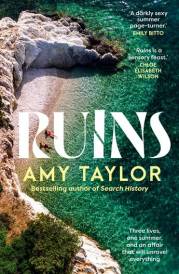Jeremy Renner Bourne Legacy
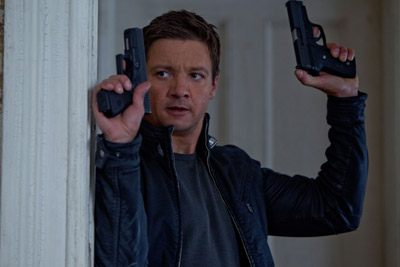
Jeremy Renner Bourne Legacy
Cast: Jeremy Renner, Rachel Weisz, Edward Norton, Albert Finney, Joan Allen, Scott Glenn, Stacy Keach, Oscar IsaacDirector: Tony Gilroy
Genre: Action, Thriller
Rated: MA
Synopsis: The narrative architect behind the Bourne film series, Tony Gilroy, takes the helm in the next chapter of the hugely popular espionage franchise that has earned almost $1 billion at the global box office: The Bourne Legacy.
The writer/director expands the Bourne universe created by Robert Ludlum with an original story that introduces us to a new hero (Jeremy Renner) whose life-or-death stakes have been triggered by the events of the first three films. For The Bourne Legacy, Renner joins fellow series newcomers Rachel Weisz, Edward Norton, Stacy Keach and Oscar Isaac, while franchise veterans Albert Finney, Joan Allen, David Strathairn and Scott Glenn reprise their roles.
Release Date: August 16th, 2012
Website: www.thebournelegacymovie.com.au
About the Production
Finding Aaron Cross: The Legacy BeginsAs the filmmakers of the Bourne franchise pondered the next chapter in the series, they faced a conundrum: At the end of The Bourne Ultimatum, the protagonist had been involved in a shootout in London's Waterloo Station and then an even more high-profile car chase gunfight through the streets of New York City. Jason Bourne had gone public in a big way. He was poised to expose the U.S. government for its litany of crimes when he vanished. Producer Frank Marshall explains the hurdle: "The challenge was 'Where are we going to go now?' Jason Bourne knew who he was, didn't want to be in the same business anymore and wanted to go off on his own. We had to create a new set of circumstances for the story to go forward."
Despite the hesitancy, Patrick Crowley, who, alongside Frank Marshall, produced the three previous entries in the series, admits that it was the fans' interest in additional stories that kept the franchise alive. "We touched a nerve with people who would come up to us and say, 'I like those movies so much. I hope you're going to be doing another one,'" offers Patrick Crowley. "If you've done three of them and then people want to see a fourth, you've done something right."
In April 2010, several months after Paul Greengrass and Matt Damon opted not to participate in this chapter of the series, producers Jeffrey Weiner and Ben Smith met with the franchise's narrative architect, Tony Gilroy, and asked him if he might spend some time thinking about how to move forward. Tony Gilroy was intrigued and agreed to see if he could find an exciting way to continue this world that he had helped to create-one that had launched a new kind of spy thriller.
Several weeks later, Tony Gilroy came back to the producers with a concept for how to approach the material. He notes: "The thing that separated Bourne most clearly from the action films of the moment was the depth and complexity of the character's problem. The idea of an assassin 'coming to' with no recollection of his dark past and paying the price for recovering his memory by realising that he's not the person he wants to be was an incredibly compelling motor. In the hands of an actor like Matt Damon, there was no limit on how honest and detailed those ideas could be expressed. It was fun to think of ways to stage the Legacy story, but until there was a new character with a new problem that felt as powerful there wasn't going to be a script. When that last piece fell into place-when Aaron Cross came into focus-when the thing that he needed became as clear and soulful to me as what we'd gone after with Bourne, that's when everyone decided it made sense to move forward."
Tony Gilroy then began work on a treatment for the project even as he outlined a blueprint for where the story might go after The Bourne Legacy. He began an in-depth research process that would serve as the underpinning for both documents. He looked most particularly at the secretive U.S. government agency known as DARPA (Defense Advanced Research Projects Agency) that is hard at work trying to figure out how to make better soldiers. DARPA and its intelligence counterpart, IARPA (Intelligence Advanced Research Projects Activity), fund many research programs with the objective of enhancing the cognitive and physical performance of American soldiers and spies. Tony Gilroy notes: "There's no drug testing in war. There's a very real appetite to have soldiers with increased energy, higher pain thresholds and less need for sleep. The warrior who heals, learns and processes information faster is the dream of every commanding officer. We're in a place now where the science has begun to make real that dream in a very unpredictable and terrifying way."
Just as in The Bourne Legacy, DARPA and its counterparts are working closely with the pharmaceutical industry, medical researchers, Silicon Valley and others to find ways to make humans into better warriors. Tony Gilroy found that there was a burgeoning post-9/11 marriage of biology and warfare: a top-secret America that has proliferated, funded by the U.S. government and staffed by scientists often working for large corporations. It has, in fact, become so large that it is impossible to fully oversee by any one branch of the U.S. government.
Offers the director: "This was an odd story to research because I was doing more confirmation than prospecting. I kept finding that my imaginative ideas for Outcome and Candent and NRAG were already there and in play. Every hint that we'd laid along the way in the trilogy about Treadstone and its science-medical background fit perfectly into the existing reality. Then it was just a matter of asking what would happen if everything went wrong."
After finishing the treatment for The Bourne Legacy, Tony Gilroy decided he would be interested in making this his next directorial effort. Although he began his career as a screenwriter, Tony Gilroy has become an accomplished director with two features to his credit: 2007's Best Motion Picture nominee Michael Clayton, starring George Clooney, for which Gilroy received Oscar® nominations for both directing and writing, and Duplicity, the 2009 romantic caper starring Julia Roberts and Clive Owen.
The producers and the studio agreed immediately and were enthusiastic about this turn of events. Says Frank Marshall: "One of the best things about the movie was getting to work with Tony Gilroy as a director. I've been involved with him on the other three movies as the writer, but way back on The Bourne Identity, I knew that someday he was going to direct. He was in the cutting room and making the kind of suggestions and solving the kind of problems in the way that a director would think about them. So, it's not a surprise that he's directing this film but it didn't start out that way."
To collaborate on the screenplay, Tony Gilroy called upon his brother, fellow screenwriter Dan Gilroy, for their first professional teaming in many years and they began work. Notes Dan Gilroy of the collaboration: "Tony Gilroy and I actually co-wrote several unproduced screenplays when we were first starting. It was an easy fit then and pretty effortless now. Our process is outlining the story together and then leapfrogging scenes or sequences. When we're working, it's seven days a week-long hours. I'm in L.A, and he's in New York, but these days distance doesn't matter. There's no ego involved. Whatever works gets used, and there were no disagreements or arguments. It was a blast. We were both on the same page and committed to tuning every element to the highest possible degree."
The two writers expanded upon the research that Tony Gilroy had done for the treatment, while also developing the intense drama of the story. Continues Dan Gilroy: "We hope Legacy lives up to its title by expanding the mythology in smart, imaginative and absolutely realistic directions. All technology referenced in the film is either in development or in use by the U.S. intel community. The hardest part of the job was creating a character with a need that makes the film personal, and Tony Gilroy had the core of that before I came on. Aaron Cross has a primal need that creates constant intimacy with the audience. The emotional journey is always in the foreground, which for me is the hallmark of all great action movies."
Frank Marshall was thrilled with the resulting script. He commends: "The genius idea was Tony Gilroy and Dan Gilroy's: Expand the world that Bourne lived in and see what else was out there and who is controlling whom. This way, we could build upon the world the audience had discovered via Jason Bourne and then have an opportunity to see new characters and the bigger picture."
Patrick Crowley agrees that the writer/director and his brother nailed it. The producer marvels at their crafting of a language specific to this series and how they connected everything in this world: "Tony Gilroy's obsessed with the intelligence community. He lives and breathes it, asking, 'How would these people think, how would they act, and what are the relationships that you would have in the intelligence community?' It thrilled me that we have a writer who is the soul of the whole series-who shows that he is an amazing director with two well received movies-come on board to direct this one."
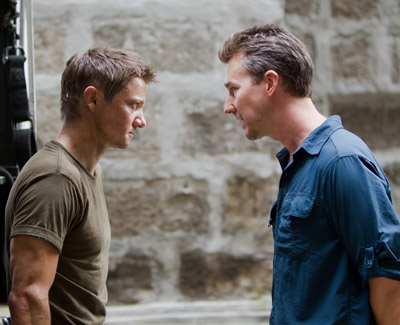 In keeping with Tony Gilroy's previous screenplays for the Bourne series, this script diverges dramatically from the plotlines of Ludlum's Cold War-era novels but retains the author's themes of conspiracy and government programs run amok. According to producer Ben Smith, this film offered the chance to build upon what had been established by the series creator, who died in 2001. "What's special about Robert Ludlum's work and about these movies is that they talk about the power of an individual," says Ben Smith. "In these times of massive corporations and governments and multinational interests, the films make us feel that we can make a difference."
In keeping with Tony Gilroy's previous screenplays for the Bourne series, this script diverges dramatically from the plotlines of Ludlum's Cold War-era novels but retains the author's themes of conspiracy and government programs run amok. According to producer Ben Smith, this film offered the chance to build upon what had been established by the series creator, who died in 2001. "What's special about Robert Ludlum's work and about these movies is that they talk about the power of an individual," says Ben Smith. "In these times of massive corporations and governments and multinational interests, the films make us feel that we can make a difference." Fellow producer Jeffrey Weiner shares Ben Smith's belief that Tony Gilroy was the right filmmaker to take the mantle. He says, "We were thrilled that Tony Gilroy not only wanted to write The Bourne Legacy, but also wanted to direct. He's one of the few people who's been with the entire series since the beginning. His understanding and feel for this world is invaluable in this process, and I think he's given the people who will go to the movie exactly what they want out of a Bourne experience."
Joining the team as executive producers are Henry Morrison and Jennifer Fox, Tony Gilroy's longtime production partner. Jennifer Fox reflects on their working relationship and Tony Gilroy's sensibilities at blending action and suspense with piercing drama. She says, "When Tony Gilroy writes, he can see the film in his mind down to the smallest detail, and his ability to focus and capture that vision is a testament to his instincts and to his creative stamina. Also, within Tony Gilroy's work there is always the essential desire for explanation of human drama. The depth of his complicated characters stem from that search for truth from character to character and scene to scene."
Tell Me Your Name: Casting the Action-Thriller
For Tony Gilroy, finding the ideal performers to give life to the screenplay was the most crucial element in putting together the film. "Everything else can be pushed and fixed or wrangled in some way," he says. "Acting is magic. I learned that a long time ago."
To play the part of Aaron Cross, the filmmakers turned to Oscar® nominee Jeremy Renner, a performer as comfortable with drama as he is with action. "The reason Jeremy Renner's such an amazing actor is that he is a complicated guy," underscores Tony Gilroy. "He's sweet and he's hard, and he lets himself draw on all of that, all the time." The director says that he's a longtime admirer of Jeremy Renner's work: "I must've watched The Hurt Locker 18 times. In every scene, he is molecularly involved with the physical aspect of what's happening at the moment. This integrity that he has, this feet-on-the-ground awareness and this surprising, explosive intelligence, made Jeremy the perfect cousin for Bourne."
Any concerns that the filmmakers might have had about Jeremy Renner's ability to transform into an action star were instantly assuaged. In fact, the director calls his leading man a "movie athlete." Tony Gilroy says: "Jeremy Renner came to us at a really high learning curve. When they took him out to the track the first time, the reports were: 'Oh my God. Wow. He can do this and this…and this…and this. We don't have to double this!' Jeremy Renner's so good that he actually was at the level where the insurance company got nervous."
"Jeremy Renner is an actor of such intensity and intelligence," adds Ben Smith. "We've seen in his performances that he comes out of the screen, grabs you by the throat and takes you on an incredible journey."
After his Academy Award®-nominated roles in both The Hurt Locker and The Town, Renner went on to make his mark as an action hero in the blockbuster Mission: Impossible-Ghost Protocol and this summer's global juggernaut The Avengers. He says that he was a fan of the Bourne series and of one man's performance in particular: "What Matt Damon did, and what the previous directors have done, was great. For those who love the franchise, I'm not replacing Matt Damon, nor would I want to. It would never have been interesting if I was taking over and playing the same character. Matt Damon is always the face of Jason Bourne and always should be. I liked this script because it was a very interesting way of continuing the story while honouring what came before."
The performer elaborates on Tony Gilroy's underlying premise that, although Cross travels in a world that is parallel to Bourne's, Cross is not aware of Bourne. Jeremy Renner reflects: "They don't know each other, so this has a whole new spin on why these supersoldier spies are the way they are now. I hope I can bring a fresh perspective to it."
Jeremy Renner goes on to share that The Bourne Legacy retains the realistic tone of the earlier films. "It doesn't veer into the CGI world or massive explosions," he says. "It stays authentic. It was important for me to want to find humanity within this character." He found his filmmakers were just as interested in these concepts. "What matters is that there is believability in everything we do in the film. No matter what the stunt is or the setup, it's all based in reality, truth and the potential of science. As an actor, that's easy to grab onto."
Unlike Bourne, Cross is well aware of who he is and where he came from: a soldier wounded in the Middle East several years ago. Once he escapes from the Yukon, Cross journeys back to the U.S. in order to find one of his few contacts in Outcome, and the only person who can help him stay alive, Dr. Marta Shearing.
Says Patrick Crowley about an issue that has perplexed the team since the beginning of the first film: One of the biggest challenges we've had is how to deal with a leading lady in the movie. With the pace and intensity of the films, it's difficult to take the time to properly develop a relationship, plus getting hooked up with Jason Bourne is usually the kiss of death. Because we have a fresh start, we can introduce a woman into the story without it feeling contrived."
The role of Marta required not only a talented actress, but also one who would be willing to take on the special demands that the part required. Explains Tony Gilroy: "Marta is an accomplished research scientist with some real emotional chaos in her private life. She's been ignoring some pretty heavy moral contradictions in her work for Outcome, and when things explode she's launched into about as hardcore an odyssey as any character I've ever written. And by the end of the film she's not just surviving, she's kicking ass. It's a demanding role."
Much to the filmmakers' delight, Academy Award® winner Rachel Weisz, known for her powerful performances in such films as The Constant Gardener, The Lovely Bones and The Whistleblower, was eager for the challenges that lie ahead and the results were more than they had hoped for. Tony Gilroy recalls: "The bar for credibility is very high in this franchise, and she gave us more than we ever dreamed of. I knew how good she was, but I was still astonished by what she brought to the film. She pretty much surpassed my expectations every day."
Marta is a workaholic, utterly devoted to her groundbreaking research as a biochemist at a top-secret lab in Maryland. Reflects Rachel Weisz: "She's at the cutting edge of science, and she thinks she's contributing to her country. But at the same time, she does secretly know that what she's doing has great moral ambiguity to it." Marta's choice to ignore the potential consequences of her trials on patients intrigued the actress. "I would be less interested in her if she were just doing something good and saving the world. What she's doing is a little dubious."
Marta's mundane life is turned upside down and she becomes a target when Outcome is rapidly shut down and she is perceived as simply residual cleanup. Aaron-a man whom she has examined multiple times in four years but doesn't know well-appears in time to save her, and the two quickly form a relationship out of necessity. "Marta is hesitant to go with him, but she doesn't have any other alternative," Rachel Weisz explains. "The people who represent law and order in her country just tried to kill her. She is a regular woman who happens to be good at science, but not good at evading the police authorities of the globe."
Rachel Weisz was intrigued by the backstories that the Gilroys had created for these two characters. "They're incredibly driven in very different ways," adds Rachel Weisz. "Marta and Aaron come from completely different backgrounds, and they end up relying on one another for different reasons. That's a really fascinating way to create a story."
While filming in New York and in Southeast Asia, Rachel Weisz discovered that she and Jeremy Renner had similar approaches to their work. "We're very different people, and we come from different backgrounds but we have a similar way of working," the actress observes. "Jeremy Renner's very free and loose and pretty wild, and wonderful to work with. I've loved every minute opposite him." Rachel Weisz also sees a bit of a rebel in her director: "Tony Gilroy has a very rock 'n' roll spirit, which is 'Let's find chaos and abandon, and let's go,' which is great for acting. He's an unusual combination in a writer/director, and I'm happy to be in his band."
To play the role of ret. Col. Ric Byer, the ruthless head of NRAG-the organisation behind the secret program of agents that began with Treadstone, evolved into Blackbriar, and now operates Outcome, among several others-the filmmakers cast Oscar® nominee Edward Norton. When Outcome is in danger of being exposed to public scrutiny, Ric Byer cuts his losses by deciding to shut it down and move on.
Fox explains how the Ric Byer character illustrates Tony Gilroy's nuanced approach to characterisation: "Tony Gilroy explores how individuals within organisations give themselves license to behave in unscrupulous ways: Tilda Swinton in Michael Clayton, both Tom Wilkinson and Paul Giamatti in Duplicity, and now Edward Norton and his team in Legacy. They're powerful antagonists because they hold their conviction and rationale about the greater good they believe to be serving. The familiar movie trope of the individual against the machine is made much more complicated, messy and real because he dramatises the reality behind individual motivations."
Tony Gilroy expands upon why the selection of this antagonist was so important: "We were casting the mastermind of the entire franchise. We knew we'd be saying to the audience that this is the guy that's been sitting beside you in the theatre for the last 12 years watching the CIA screw everything up for him. We needed a world-class actor; we needed weight. We needed someone with the kind of intelligence that's in the room before the scene starts, and above all I needed an actor I could collaborate with to make sure that Ric Byer's worldview wasn't painted entirely black. He believes he's one of the very few people who can bear the moral weight of the darkness necessary to keep his country safe."
Edward Norton describes his interest in joining a film with a story rooted inside the chambers of government-funded intelligence: "I see a theme running through all of Tony Gilroy's films that I think is timely and smart. He's been digging into the way that corporations have permeated our culture and threaten to compromise us from different angles. I liked that in this film he was exploring the way that power is exercised in the nexus between corporations and government...questioning who's working for who."
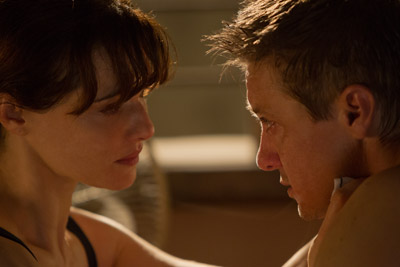 The performer appreciated that Tony Gilroy coloured his characters in moral gradations. Though Ric Byer is hell-bent on erasing Outcome, his motives (in his mind) are sound ones. Shares Edward Norton: "All of the characters in this film are painted in shades of gray. Tony Gilroy hasn't woven a web of heroes and villains. Everybody's made certain compromises and certain rationalisations in and around what they do...my character certainly, but Rachel Weisz's too and even Jeremy Renner's. He's digging into how people have their best ideals and impulses co-opted by a system in many different ways. I like that kind of complexity."
The performer appreciated that Tony Gilroy coloured his characters in moral gradations. Though Ric Byer is hell-bent on erasing Outcome, his motives (in his mind) are sound ones. Shares Edward Norton: "All of the characters in this film are painted in shades of gray. Tony Gilroy hasn't woven a web of heroes and villains. Everybody's made certain compromises and certain rationalisations in and around what they do...my character certainly, but Rachel Weisz's too and even Jeremy Renner's. He's digging into how people have their best ideals and impulses co-opted by a system in many different ways. I like that kind of complexity." Frank Marshall was impressed by Edward Norton's ability to straddle the line between a man of his country and a cold-blooded executioner who sees the emergence of Bourne as an infection that must be contained. The producer commends: "Edward Norton kills it. He's just a spectacular actor and is terrific at playing the 'villain' in the piece. But Ric Byer is not simply a villain. He's just the guy who's after Aaron Cross. Though we've had several of these types along the way, Edward Norton is a particularly tough one."
To cast the roles of Ric Byer's staff-the scientists, intelligence and surveillance experts who hunt down Aaron and Marta from their hub in Washington, D.C.- Tony Gilroy delved into the world of New York theatre. "Tony Gilroy's a New York guy," shares Patrick Crowley. "He knows both theatre and New York film very well. It's exciting to draw from that pool of people."
Tony Award winner Donna Murphy (of Broadway's Passion and The King and I), was cast as Ric Byer's dedicated second-in-command, Dita, the "nun" to Ric Byer's "priest." "She's his wingman, or wingwoman," Donna Murphy explains. "She's got a background with the CIA; she's an extremely good scientist. The biggest part of her job is to be so tuned in on Byer that when he needs something, she's three steps ahead."
Other performers who were brought aboard to play key members of Ric Byer's team include Obie Award winner Michael Chernus as Ingram, and Corey Stoll, recently nominated for a Drama Desk Award for off-Broadway's Intimate Apparel and who made a memorable appearance as Ernest Hemingway in Midnight in Paris, as Vendel.
As Aaron and Marta prove elusive, news of a government subcommittee investigating Blackbriar adds to the tense atmosphere in the crisis suite where Ric Byer and his staff are holed up. Likely most disturbed by the program becoming public is Terry Ward, the head of a company with intimate ties to Outcome. Terry Ward is played by New York theater actor Dennis Boutsikaris, the Obie Award winner for Sight Unseen. Dennis Boutsikaris describes Terry Ward's relationship with Ric Byer as contentious, with Terry Ward ultimately outgunned. "Terry Ward wants to think that he's Ric Byer's superior, and he clearly is not," the actor shares. "Terry Ward wants to be a leader without any leadership qualities."
At Tony Gilroy's suggestion, Dennis Boutsikaris had his hair cut and trademark beard shaved in order to play the corporate suit. "We talked on the phone, and Tony Gilroy told me that the hair and everything had to go," Dennis Boutsikaris remembers. "The whole feeling was how slick he wanted to make my character."
As tension escalates in the war room, Terry Ward also clashes with the imposing ret. Adm. Turso. The military commander who oversees Outcome is played by veteran actor Stacy Keach, who describes his character as "a patriot and a man whose authority is there." Adm. Turso speaks to his team in an intricate language that is quite specific to the work. Reflects Stacy Keach: "Tony Gilroy is an extraordinary talent because he creates his own language. The Bourne franchise has one of its own. It's intelligent, human and very personal. The trick with this kind of dialogue is to make it conversational and just sort of throw it away without making it too melodramatic."
Stacy Keach acknowledges that the scenes with Turso, Ric Byer and the NRAG team were especially engaging. "The great thing about this franchise is the amazing balance between action, adventure, intrigue and suspense," he says. "You have two very different environments: the outside environment where you follow Cross and his exploits over the world, and then you have the crisis room or the surveillance environment. As an audience member, that combination keeps you on the edge of your seat because you are seeing something at the same time the people in the movie are watching it."
Rounding out the cast members who are new to the Bourne franchise are Oscar Isaac and Louis Ozawa Changchien. Oscar Isaac describes Outcome #3's early interactions with Cross as "like a Western." He shares: "My character has been living in a cabin for a month by himself with zero communication with the outside world…other than the occasional drop by of one of these guys." When Cross arrives at #3's remote base several days early, #3 is suspicious; similarly, Cross doesn't trust his counterpart. "They're like these dogs that are circling and sniffing each other," suggests Oscar Isaac. They're not necessarily posturing so much as they are uncertain. It's dangerous."
It turns out that #3 isn't the only one that Cross (aka #5) should be concerned about. Ric Byer hedged his bets that Outcome would not be the endgame. He has another program in motion, and it is known as LARX.
Louis Ozawa Changchien, who, in the role of LARX #3, an operative based in Bangkok, had to be comfortable with speed and with great heights. "I think of LARX as the decathlete of spies," laughs Louis Ozawa Changchien, a theatre actor who recently starred in Predators. In order to prepare for the role, Louis Ozawa Changchien travelled from his native New York to L.A., where he rehearsed with 2nd unit director Dan Bradley's team for several weeks. In this boot camp, Louis Ozawa Changchien learned the fundamentals of parkour-how to move around obstacles with speed and efficiency-practiced jumps from great heights and completed an intensive course in stunt driving. That would come in handy as his character chases Marta and Aaron through the narrow, crowded streets of Manila.
Fans will also be treated to cameos from several characters from earlier Bourne films, including series favorites Albert Finney as Dr. Albert Hirsch, Joan Allen as Pam Landy, David Strathairn as Noah Vosen and Scott Glenn as Ezra Kramer.
Shooting Across the Globe: Locations and Design
In November 2010, while writing the screenplay, Tony Gilroy journeyed around the world to visit the locations where his story would be set, just as he did for the other Bourne films. From the Canadian Rockies to Southeast Asia, he tailored the action to the specific locales. He reflects: "The great ride for the past 12 years has been getting on a plane and taking these incredibly specific and unusual tours of places that no one else would ever see because you're looking at them from a Bourne point of view."
According to Patrick Crowley, who once again accompanied Tony Gilroy on the tour, the series has been unique in the manner in which it showcases parts of the world rarely seen in cinema. He notes: "We were one of the very first big movies to shoot in Berlin, and there had only been a couple of contemporary Hollywood shows before us in Moscow."
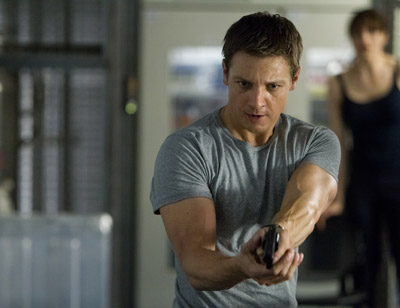 The Bourne Legacy would be no exception. Tony Gilroy chose to broaden the story to a setting beyond Europe, where much of the previous three films had taken place. "Patrick Crowley and I travelled all over Southeast Asia and scouted," Tony Gilroy continues. "And then I wrote into the specific, real locations. That's how we've always done it. There isn't an action sequence in any of these films that hasn't been written into the place itself."
The Bourne Legacy would be no exception. Tony Gilroy chose to broaden the story to a setting beyond Europe, where much of the previous three films had taken place. "Patrick Crowley and I travelled all over Southeast Asia and scouted," Tony Gilroy continues. "And then I wrote into the specific, real locations. That's how we've always done it. There isn't an action sequence in any of these films that hasn't been written into the place itself." As The Bourne Legacy rockets from Washington, D.C. and Manhattan to Alaska and Southeast Asia, Tony Gilroy retains the spirit of the previous Bourne films. "It wants to feel like the world we really live in," the director says. "We go to exotic places, but we don't glamorise them. It's a realistic approach to action, and it will be familiar in all those ways."
Jeffrey Weiner appreciates the detail the writer/director gives to this story. He offers: "Some of the locations for this movie are not places people go to every day. The fact that it is real and gritty and that we are close and in-your-face gives a perspective that you don't find in the guidebooks."
Helping Tony Gilroy to construct this world were key contributors to the film's visual style: production designer Kevin Thompson, who crafted Michael Clayton and Duplicity with Gilroy, and cinematographer Robert Elswit, the Academy Award®-winning DP for There Will Be Blood whose previous work also includes Michael Clayton and Duplicity, as well as The Town and Mission: Impossible-Ghost Protocol, both with Jeremy Renner.
Discussing Kevin Thompson, Tony Gilroy commends: "Kevin Thompson's built up a very, very strong body of work, and we formed an essential collaboration over the course of Michael Clayton and Duplicity, but I think Legacy is going to show a lot of people that there's nothing he can't tackle. Legacy was a huge design project that went from big-time stage work through location building and then into Manila and all of its challenges-all of that with the mandate of staying absolutely photo-real at all times. It was the highest degree of difficulty, and he crushed it."
The director was just as pleased to join Robert Elswit for another project. Tony Gilroy says: "Working with Robert Elswit on these three films has been about the best collaboration I can imagine. He's the remarkable combination of deep experience, imaginative freedom and sled-dog endurance. We'd been through the shit together so many times before this film started, and thank God, because I can't imagine trying to do something this long and large with someone who wasn't at your side in every way."
Robert Elswit and 2nd unit director Bradley could shoot all the footage in the world, but if it wasn't cut together correctly, there would be no scene. Joining the team as editor was another member of the Tony Gilroy family, John Gilroy, the director's fellow collaborator on his last two films. Notes John Gilroy of his working relationship with his brother Tony Gilroy: "I work with Tony Gilroy essentially the same way that I work with other directors. I try to understand their vision of the film and get on that same wavelength. If I can make their vision my own, I have a real compass to navigate me through the editing process. With Tony Gilroy, that sort of deep understanding between director and editor came very early on and has stayed with us and grown through all three films. We have very similar sensibilities, and most of the time we see eye to eye on things."
Tony Gilroy returns: "John Gilroy is a machine. It's a complex movie, and we shot in a weird order. The pace is relentless, and we were shooting a great deal of film. The need to know exactly where you stand and what you owe is essential. But he's not just cutting and reviewing material as we go; he's building sequences and road testing scenes that are coming at us with a consistent level of detail that's shocking sometimes. He's a total filmmaker. I can't imagine even trying this without him beside me."
War Rooms and "Southern" Mansions: Filming in New York
After two days of filming in Seoul, South Korea, principal photography began at Kaufman Astoria Studios in Queens, New York, where all of the movie's stage work-including D.C. interiors-was shot. Filming began with scenes involving Ric Byer and his team at the Virginia-based NRAG, the group that designed the government's program of killer spies. As Bourne's exploits go public, Ric Byer's experts use every mode of technology available to minimise the damage. Here, Kevin Thompson's crew built the crisis suite, the small amphitheatre where Ric Byer's team holes up for days. Patrick Crowley describes the film set as "like 25 people playing high-speed chess."
At Kaufman, Kevin Thompson built the lab where Marta engages in her pioneering work. The designer's biggest set, however, was three stories high on Kaufman's largest stage. Here, he created Marta's home in the Maryland woods, which he didn't initially plan to build. "We started by trying to find a real location that would either inspire us or lead us to what we were looking for," Kevin Thompson recalls. "Tony Gilroy wanted to have a house that was a bit of a fairy-tale fantasy: a larger-than-life decayed mini-mansion that Marta invested in when she was in a relationship, a place she hoped to someday restore."
The kickoff to Marta and Aaron's journey, the house is where the two realise that they must team up. "We found the magical house up in the Hudson Valley about two and a half hours north of New York City," Kevin Thompson recounts. "It was built in 1815 and had a romantic, picturesque style. Although we looked at 150 houses, this one was by far the one that spoke most to us."
Unfortunately, their prized location, the national historic landmark known as the Plumb-Bronson House in Hudson, New York, was in need of even more rehabilitation than Marta's fictional home. "About six weeks from shooting, the owners association told us that it was going to be impossible to allow us to shoot there," says Kevin Thompson. It turns out that the structure could not support the equipment and crew necessary for filming.
Kevin Thompson's team quickly set about re-creating the interior of the house in precise matching detail. his included reimagining its parlors and vestibules, magnificent three-story elliptical staircase, peeling paint and faded wallpaper on the stage at Kaufman Astoria. While unanticipated, building Marta's house on a stage did offer several advantages, including greater flexibility and control with lighting and camera placement for DP Elswit's equipment. "Having the three floors on the stage provided some great sight lines for action," says Kevin Thompson. "It was a pretty photogenic set."
In the end, the production travelled to Hudson to film the exterior of the Plumb-Bronson House for a key scene with Aaron, but other scenes outside Marta's home were filmed at William H. Pouch Scout Camp, a 143-acre site in Staten Island, New York. Unlike Plumb-Bronson's surroundings in Hudson, the Staten Island location offered the thick woods that surround Marta's home in Tony Gilroy's story.
Among the many other New York area locations where the film shot were JFK Airport, The New York Times printing plant in Flushing, Federal Plaza in Lower Manhattan, and residential areas of Syosset and Old Westbury in Long Island.
Frigid Waters in Calgary: Capturing the Canadian Wilderness
After 12 weeks of filming in the New York area, the production decamped and left the city for an environment where the Bourne series had never before ventured: the untamed wilderness. For two weeks in December 2011, the cast and crew filmed in Kananaskis Country, a system of parks renowned for its spectacular scenery, in the Canadian Rocky Mountains west of Calgary. The dramatic Canadian landscape filled in for the Alaskan Yukon, where Cross finds himself as the story begins.
"We did a lot of scouting by helicopter," recalls Kevin Thompson, whose locations included remote mountaintops, a frozen lake and a riverbank beside which his crew could build a log cabin, a heavily wooded area and a waterfall. "We looked all over Canada and found most everything within a 30-minute radius of Kananaskis."
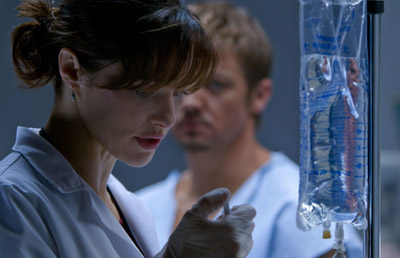 One element of the Canadian shoot remained a wild card: snow. "Our location manager, who's done a million movies there, said, 'I can't guarantee you that there's going to be any snow,'" Patrick Crowley recalls. "So we had snow machines standing by, and we were ready to make our own." But the Bourne crew enjoyed some luck: Plenty of snow arrived just in time for the shoot. "The day after we left, there was a warm wind called a Chinook that came through and melted all the snow," he adds. "We didn't hear about it until about a month afterward…and I'm kind of glad we didn't hear about it until then."
One element of the Canadian shoot remained a wild card: snow. "Our location manager, who's done a million movies there, said, 'I can't guarantee you that there's going to be any snow,'" Patrick Crowley recalls. "So we had snow machines standing by, and we were ready to make our own." But the Bourne crew enjoyed some luck: Plenty of snow arrived just in time for the shoot. "The day after we left, there was a warm wind called a Chinook that came through and melted all the snow," he adds. "We didn't hear about it until about a month afterward…and I'm kind of glad we didn't hear about it until then." The Bourne Legacy opens with an echo of the image that introduced Jason Bourne to filmgoers in The Bourne Identity: seen from below, a man floats motionless in water. However, unlike Bourne, who had been left to drown in the Mediterranean Sea in the first film, Aaron Cross is uninjured. After a brief moment of stillness, Cross reveals his incredible stamina: He has deliberately submerged himself in frigid waters in order to retrieve a canister left for him at the base of a freezing waterfall.
To shoot this scene, the filmmakers did everything they could to keep their lead actor safe in the cold water. "We were concerned from the very first time that we saw the location," says Patrick Crowley. "Even for just going in to his waist, we had a helicopter bring a hot tub there. We had a dry room that was heated. We had an ambulance standing by, and we had three or four people on the set whose specialty was hypothermia."
The initial plan was to shoot only part of the scene in Canada, with Jeremy Renner in a full wet suit and in the cold water only up to his waist. However, just before rolling, Jeremy Renner removed the wet suit's top
MORE
- Emma Stone Magic in the Moonlight
- Jessica De Gouw Cut Snake
- Maxine Peake Funny Cow
- Denzel The Equalizer 2
- Johnny Flynn Beast
- Logan Marshall Green Upgrade
- Shailene Woodley Adrift
- Eric Toledano and Olivier Nakache C'est La Vie...
- André Leon Talley The Gospel According To André...
- Shakespeare In Tokyo
- Mission: Impossible Fallout
- Glenn Close The Wife
- Allison Chhorn Stanley's Mouth Interview
- Benicio Del Toro Sicario: Day of the Soldado
- Dame Judi Dench Tea With The Dames
- Sandra Bullock Ocean's 8
- Chris Pratt Jurassic World: Fallen Kingdom
- Claudia Sangiorgi Dalimore and Michelle Grace...
- Rachel McAdams Disobedience Interview
- Sebastián Lelio and Alessandro Nivola...
- Perri Cummings Trench Interview


